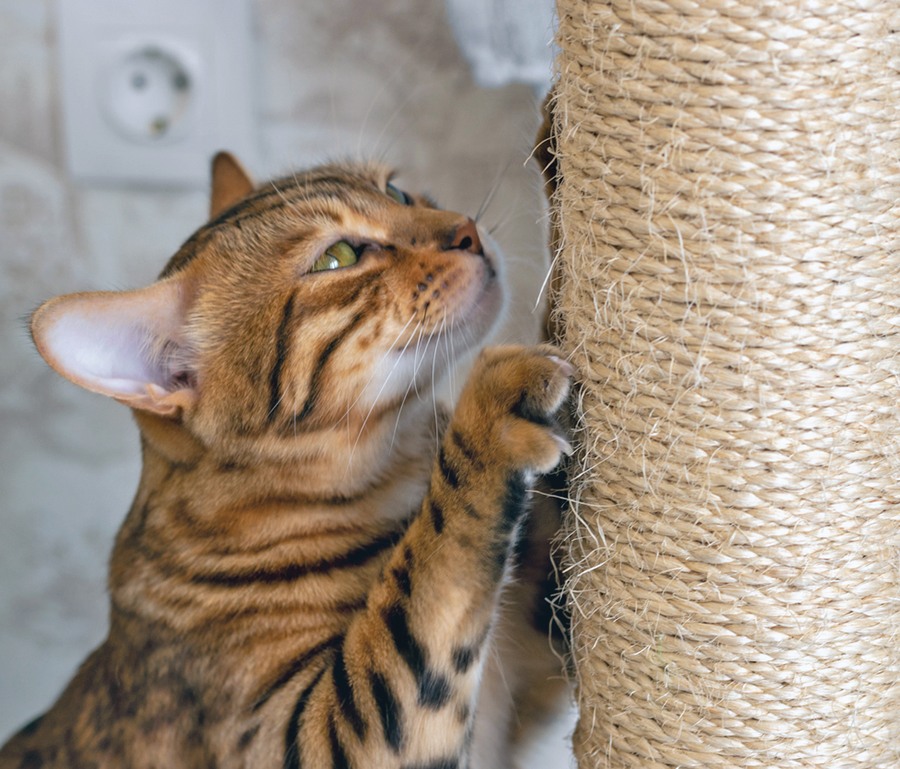Scratching things is normal. Some cats scratch during a wake-up stretch. Others scratch before heading off into a playful set of zoomies. Scratching is natural. It’s important for keeping their nails healthy and removing old sheaths. It also lets a cat spread her scent via the scent glands on her paws.
Unfortunately, cats are often relinquished to shelters because of destructive scratching. When left to pick their own surfaces to relieve that urge to scratch, cats may choose furniture, carpet, or walls. Understandably, homeowners and landlords don’t appreciate those choices.
While prevention starting at a young age is key (see sidebar), all is not lost if your cat is already an established scratcher. “Put a proper scratching post in the proper place, near the scene of destructive scratching. Try to match the type of surface the cat has chosen. Be sure to provide horizontal as well as vertical scratching surfaces,” says Katherine A. Houpt, VMD, PhD DACVB James Law Professor Emeritus, section of behavior medicine, Cornell University College of Veterinary Medicine.
Regular nail trimming will do wonders to temper her urge, as old nail sheaths won’t need to be removed. Trimmed nails also decrease the damage done if your cat does scratch. The ideal length of time between nail trims can vary between two and four weeks, so you may need to watch to see how often your cat needs trimming. It’s easy to forget, so make a note on your calendar for when she’s due for another trim.
You can deter scratching by:
- Using a good scratcher placed in the right spot
- Regularly trimming cat nails
- Applying furniture guards
Methods with a lower success rate:
- Denying access to preferred scratching spots
- Using water pistols
- Applying nail caps
If your cat is new to nail trimming, start slowly. When your cat is relaxed in your lap, push gently on a pad so the nail extends. Use a cat nail trimmer or human toenail cutter to cut off the “hook” of the nail, then reward your cat with a treat and praise. If she is calm, do another nail. Gradually build up to an entire foot at a time. Some cats will even handle getting all four feet done at once.
Deter the Destruction
Make potentially attractive but inappropriate choices less appealing. Bitter chew sprays may deter some cats. “Booby trapping” an area with stacked plastic cups or double-sided tape can provide good deterrence, as can some commercially available motion-activated products that emit a harmless puff of air when a cat approaches them.
Some people have luck with a water squirt gun, but this is not our favorite method, as cats can develop aversions to people that squirt them. Denying access to preferred scratching places is a last resort.
The commercial market is full of interesting products to help you discourage a dedicated scratching cat. You can get furniture guards and combo furniture guards/scratching posts that fit against and around the corners of furniture that your cat wants to scratch. They protect your furniture but give your cat a good scratching option in the location she obviously likes.
Vinyl furniture guards are less expensive but can stop a determined cat. Nails can’t penetrate this material so your cat will hopefully move on to a more cat-friendly option. Again, it helps to put this option right near the location your cat likes if you choose to try it.
Some cat owners find that nail caps work great for them. These are soft covers put on your cat’s nails to prevent them from hooking into fabric or furniture when they scratch. The nail caps require the use of an adhesive and a reasonably cooperative cat to get them on. Most caps will adhere for four to six weeks. “Consider Soft Paws (glue on nail covers) for emergency situations such as a wedding dress in the house,” suggests Dr. Houpt.




